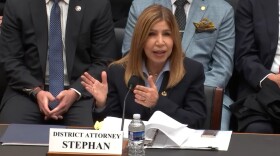Jerry Abrams, a 64-year-old marketing strategist in Minneapolis, used to run marathons.
But two decades of degenerative spine disease have left him unable to run — and he's grieving.
For Abrams, losing running felt like "the loss of a loved one – that friend who's been with you every day you needed him.
"You know, having that taken away from you because of pain is the hardest thing of all," he says.
The constant pain in his lower back makes running impossible. Sometimes, when the pain isn't under control, he can't get out of bed.
Abrams has tried taking opioids. They help, but he feels he has to be careful because they're potentially addictive. He's also worried about building up a tolerance to them.
"I don't ever want to be in a situation where I need surgery and need to recover and opioid medication no longer does what it needs to do," he explains.
The Food and Drug Administration approved a new non-opioid drug earlier this year called Journavx. It's a pill for severe acute pain that works by blocking plain signals from where someone hurts.
It's offered hope for the 1 in 5 Americans who suffer from chronic pain, but it's also just out of reach. Journavx is the first new kind of painkiller in more than 20 years, and the medical community is cautiously optimistic that Journavx doesn't have the same addictive potential as opioids do.
But the new pills are expensive, and not everyone has been able to access them, thanks to a narrowly-focused FDA approval and limited insurance coverage
Abrams' doctor wanted him to be able to try Journavx. But the FDA only approved the medication for short-term use for acute pain, which is usually defined as lasting less than three months, such as right after surgery.
Because Abrahm's pain is chronic, his insurance wouldn't cover it.

Journavx's FDA approval was based on studies of patients right after surgery. But even in those cases, insurance coverage has been slow.
"I think overall surgeons were very excited about the option to have a non-opioid pain medicine for our patients," says Dr. Jessica Burgess, a surgeon at Eastern Virginia Medical School at Old Dominion University in Norfolk, Virginia. "Unfortunately, I have yet to meet a surgeon that's been able to prescribe it."
In Massachusetts, by contrast, insurance coverage has improved in the last few months, says Dr. Antje Barreveld, president of the American Academy of Pain Medicine.
Opioids, which are off-patent and generic, cost just a few cents per pill. Journavx costs around 15 dollars per pill, she says.
Even with insurance, that can mean a significant difference at the pharmacy counter, as Barreveld learned when a family member was prescribed both medications after a recent surgery.
"The oxycodone cost about, I think, $0.50 and the Journavx was a $30 co-pay. So the differences are definitely stark," she says.
Some patients who got insurance approval for a first round of Journavx are then denied when trying to get a refill after two weeks.
About 38% of people have insurance coverage for Journavx, according to Jayne Hornung, Chief Clinical Officer at MMIT, a data company focused on the pharmaceutical market. That's a pretty typical level of coverage for the first few months following a new drug's launch.
The reason why most insurers are only covering it for 14 days is because that's how long the drug was studied during clinical trials, Hornung says.
"We know it's not addictive within 14 days. But what about after 14 days?" she says.
"Also, what are the long-term side effects?" she says."We know it's okay at 14 days, but do we know at 30 days if you're going to have some long-term side effects from the drug? What about a year?"
The limited use has been frustrating for some chronic pain patients, who told NPR they tried but failed to get a prescription for Journavx.
As for Jerry Abrams, the ex-marathoner, he and his doctor were eventually able to get a coupon from Vertex Pharmaceuticals, the drug's maker, to help pay for a few months of Journavx.
Instead of paying for it himself, which would have cost more than $500 every two weeks, with the coupon Abrams would only have to pay $30. But the coupon was only good for four prescription fills.
Abrams tried it for about two months.
The drug didn't relieve the main source of pain in his spine, he says, but did help ease pain in his shoulder and mid-back.
"I find it really interesting that it has had positive effects on the secondary pain from my back issues."
His doctor is trying to find a way for him to stay on the drug after his coupon runs out.
Studies are now underway that could help Journavx win additional FDA approvals for some kinds of chronic pain. Vertex says it is specifically studying Journavx in patients with diabetic peripheral neuropathy, painful nerve damage in the limbs, and lumbosacral radiculopathy, a type of low-back pain caused by a pinched nerve.
Copyright 2025 NPR






